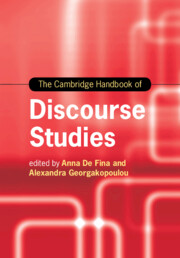Book contents
- The Cambridge Handbook of Discourse Studies
- Cambridge Handbooks in Language and Linguistics
- The Cambridge Handbook of Discourse Studies
- Copyright page
- Contents
- Figures
- Tables
- Contributors
- Preface
- Part I (Con)Textualizing Discourses
- Part II Perspectives and Modes of Analysis
- Part III Discourse Materialities and Embodiment
- Part IV (Trans)Locations and Intersections
- Part V Ethics, Inequality and Inclusion
- Part VI Discourses, Publics and Mediatization
- 27 The Critical Analysis of Genre and Social Action
- 28 Rhetorics, Discourse and Populist Politics
- 29 The Discourses of Money and the Economy
- 30 Corporate Discourse
- 31 Mediatized Communication and Linguistic Reflexivity in Contemporary Public and Political Life
- 32 Discourse Analysis and Digital Surveillance
- Index
- References
29 - The Discourses of Money and the Economy
from Part VI - Discourses, Publics and Mediatization
Published online by Cambridge University Press: 28 September 2020
- The Cambridge Handbook of Discourse Studies
- Cambridge Handbooks in Language and Linguistics
- The Cambridge Handbook of Discourse Studies
- Copyright page
- Contents
- Figures
- Tables
- Contributors
- Preface
- Part I (Con)Textualizing Discourses
- Part II Perspectives and Modes of Analysis
- Part III Discourse Materialities and Embodiment
- Part IV (Trans)Locations and Intersections
- Part V Ethics, Inequality and Inclusion
- Part VI Discourses, Publics and Mediatization
- 27 The Critical Analysis of Genre and Social Action
- 28 Rhetorics, Discourse and Populist Politics
- 29 The Discourses of Money and the Economy
- 30 Corporate Discourse
- 31 Mediatized Communication and Linguistic Reflexivity in Contemporary Public and Political Life
- 32 Discourse Analysis and Digital Surveillance
- Index
- References
Summary
While the financial crisis of 2007–8 has served to focus attention on the language of economics and the financial markets, discourse analysts have long been interested in the language of money. Indeed, because money is a social relation, the raw material available to analysts is almost too rich. I therefore draw attention to work that might not immediately look like “money talk.” I also describe the rich variety of work on metaphors of money, economics and finance of which there is an abundance. This research makes clear the ideological struggles around the representation of money and markets. In particular, it clearly shows the erasure of humans and human agency. These struggles are further illuminated by work informed by CDA and multimodal approaches, particularly in relation to the global financial crisis, austerity and poverty porn. It is important that the ideological baggage carried by contemporary understandings of money and debt are described. Research has gone further in its critique of the origins and effects of these ideologies. Finally, the contribution that applied linguists can make around money and debt is significant. However, in order to make positive interventions that emerge from considered critique, a clear set of values is required. Here, too, recent work in linguistics offers valuable perspectives as it focuses on real people in real pain.
Keywords
- Type
- Chapter
- Information
- The Cambridge Handbook of Discourse Studies , pp. 644 - 665Publisher: Cambridge University PressPrint publication year: 2020
References
Further Reading
Working with audience responses to an artwork “Capitalism Works for Me!” (by Steve Lambert), Chun analyzes responses to and critiques of people’s understanding of capitalism in their lives.
This book offers an incisive account of neoliberal ideology and its effects on both language and practice in contemporary life. It examines the increasing reach of the “market” and the key figure of the “entrepreneur.” It provides a robust treatment of ideology and how this links to language specifically and linguistics more generally.
This landmark book documents and critically analyzes the effect of market thinking in domains like education, government, religion and self-promotion. The context of each domain is clearly provided while detailed analysis of texts ranges from the lexical through the multimodal to the linguistic landscape.
References
- 1
- Cited by



